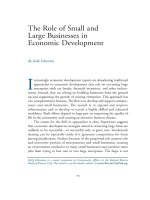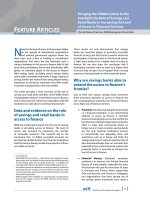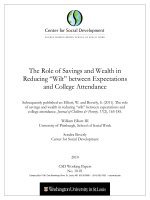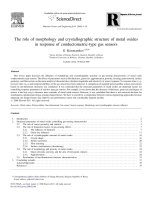The role of leadership and employee’s condition on reaction to organizational change
Bạn đang xem bản rút gọn của tài liệu. Xem và tải ngay bản đầy đủ của tài liệu tại đây (1.18 MB, 8 trang )
Available online at www.sciencedirect.com
ScienceDirect
Procedia - Social and Behavioral Sciences 172 (2015) 471 – 478
Global Conference on Business & Social Science-2014, GCBSS-2014, 15th &16th December,
Kuala Lumpur
The role of leadership and employee’s condition on reaction to
organizational change
Wustari L.H. Mangundjayaa, Dharmayati B. Utoyoa, and Permata Wulandarib*
a,b
c
Faculty of Psychology, Universitas Indonesia, Depok 16424, Indonesia
Faculty of Economic,Universitas Indonesia, Depok 16424, Indonesia
Abstract
Organizational change plays an important to achieve the success of organizational change. The objective of this paper is to identify
the role of leadership and employee condition on reaction to organizational change. This study was conducted at state-owned
organizations with 539 respondents. The results showed that job satisfaction act as mediator between change leadership and
individual readiness for change and commitment to change, and employee engagement was not significantly correlated with
commitment to change. This research is important for organizational change management in order to plan and implement changes
more effectively.
©
by Elsevier
Ltd. by
This
is an open
© 2015
2015Published
The Authors.
Published
Elsevier
Ltd.access article under the CC BY-NC-ND license
( />Peer-review under responsibility of GLTR International Sdn. Berhad.
Peer-review under responsibility of GLTR International Sdn. Berhad.
Keywords: Commitment to change; individual readiness for change; change leadership; job satisfaction; employee engagement.
1. Introduction
In order to survive in the competitive world like today, every organization has to be aware with the external demands
of the environment, and organizational change is one of the strategies to adjust the environment. However, not every
organizational change program was successful, there are even more than 50% of the change program were failed
(Pritchett, 1997). There are many variables that influence the results of change such as the content of the change; the
* Corresponding author. Tel.: +627272425;
E-mail address:
1877-0428 © 2015 Published by Elsevier Ltd. This is an open access article under the CC BY-NC-ND license
( />
Peer-review under responsibility of GLTR International Sdn. Berhad.
doi:10.1016/j.sbspro.2015.01.385
472
Wustari L.H. Mangundjaya et al. / Procedia - Social and Behavioral Sciences 172 (2015) 471 – 478
process of the change; the context of the organization and the people in the organization that involve with the change
(Walker, Armenakis, & Bernerth, 2007; Galpin 1996).
On the other hand, many researches showed that the important variable in terms of the success of change is people,
as without the supports of the people, whatever good the change program was developed, the change program cannot
be achieved successfully. In this regard, people not only should be ready to organizational change, but they also have
to be committed with the change (Herscovitch & Meyer, 2002).The success of organizational change lies on people,
in this regard on their employee’s commitment to change. As a result, it is very important to identify what are the
variables that might increase people’s commitment to change.
In relation with organizational change, previous research always mention about the importance of leader and its
leadership style in organizational change, as with a good leader organizational change can be achieved successfully
(Balogun & Hailey, 2008). On the other side, researchers also mentioned the importance of people and its
characteristics in order to achieve organizational change. Based on that discussion, this study will identify the
importance and the contribution of people, in this regard the condition of people in reaction to organizational change,
(which will be discussed by individual readiness for change and commitment to change) as well as the importance of
leadership when they led the process of change (change leadership) on commitment to change.
2. Literature Review
Literature review will discuss about commitment to change, individual readiness for change, change leadership, job
satisfaction and employee engagement.
x Commitment to Change
The concept of Commitment to Change by Herscovitch & Meyer (2002) was derived from the concept of
organizational commitment (Meyer & Allen, 1991) as an extension of the concept of organizational commitment at
the special condition of the organization, that is during the organizational change (Herscovitch & Meyer, 2002). In
this regard, Herscovitch & Meyer (2002) define commitment to change as a force (mind-set) that binds an individual
to a course of action deemed necessary for the successful implementation of a change initiative.
Furthermore, Herscovitch & Meyer (2002) have mentioned that there are three types of Individual Commitment to
Change as follows: a) Affective commitment to change (AC2C) refers to a desire to support a specific change being
introduced in the workplace, or desire to provide support for the change based on a belief in its inherent benefits to
change; b) Continuance commitment to change (CC2C) refers to the employees understanding that resistance to
change is associated with specific costs to the company and to themselves; they remain committed due to the high
cost of leaving; and c) Continuance commitment to change (CC2C) refers to the employees understanding that
resistance to change is associated with specific costs to the company and to themselves; they remain committed due
to the high cost of leaving.
x Change Leadership
Herold et al. (2008) and Liu (2010) stated that change leadership is the behaviours that target at the specific change
consist of visioning, enlisting, empowering, monitoring, and helping with individual adaptation (Herold, 2008; Liu,
2010). Moreover, Liu (2010) mentioned that there are two factors in Change Leadership namely, a) Leaders’ Change
Selling Behavior, action that attempts to promote the change during the unfreezing stage, make it clear why the change
was necessary, and b) Leaders Change Implementing Behavior, action to push a change forward and consolidate
success throughout the implementation.
x Individual Readiness for Change
Hanpachren (1997) definediindividual readiness for change is the extent to which individuals are mentally,
psychologically, or physically ready, prepared, or primed, to participate in organization development activities. He
further developed the instrument to measure individual readiness for change based on three dimensions as follows;
(1) resisting; (2) participating; and (3) promoting. Resisting is the negative attitude of the individual toward change.
Participating is the individual participation in the change process. Promoting is about how far a person would like to
implement the change process. In this paper the researchers used the concept by Hanpachern (1997).
x Job Satisfaction
There are many definitions about job satisfaction, namely: Job satisfaction is the degree to which people like
(satisfaction) or dislike (dissatisfaction) their jobs (Spector, 2002). Another definition of job satisfaction and job
dissatisfaction is that job satisfaction is a pleasurable emotional state resulting from the appraisal of one’s job as
Wustari L.H. Mangundjaya et al. / Procedia - Social and Behavioral Sciences 172 (2015) 471 – 478
achieving or facilitating one’s job values while job dissatisfaction is the un-pleasurable emotional state resulting from
the appraisal of one’s job as frustrating or blocking the attainment of one’s values. Furthermore, Jewell (2009)
introduced the facet concept of job satisfaction.
According to Jewell (2009), job satisfaction is employee satisfaction consists of many aspects in their works, which
can be measured totally or partly. The facets of job satisfaction according to Spector (1997) are as follows: Pay,
promotion, fringe benefit, supervision, and co-worker, operating conditions, nature of work, communication, and
reward. In this research, researchers will use the concept of job satisfaction by Spector (2002).
x Employee Engagement
Employee Engagement consists of energy and passion that possess by the employee to work according their roles
and status (Hewitt, 2010). Furthermore, Hewitt (2010), mentions that employee engagement consists of three
dimensions, namely: a) Stay, that is the willingness of the employee to continue as being part of the organization; b)
Strive, the willingness of the employee to give maximum efforts to do things that increase the organization
productivity; and c) Say, the willingness of the employee to express about the pride of the organization.
3. Methods
Participants for this study were 539 employees who worked at two financial state-owned organizations. Sample
was collected from two financial state-owned companies that had undergone some organizational changed, such as
restructuring the organizational, development of strategic marketing, and changes on general system and procedures.
Sampleswere chosen by convenience sampling.
Data was collected through 5 types of questionnaires, namely: 1) Commitment to ChangeInventory,(Herscovitch
& Meyer, 2002), which was developed and modified to Indonesian language, consists of 18 items;2) Change
Leadership Inventory, which was developed and modified from the concept of Herold, Fedor,& Liu(2008), consist of
two factors in Change Leadership namely: a) Leaders’ Change Selling Behavior; b) Leaders Change Implementing
Behavior; 3) Individual Readiness for Change Inventory (Hanpachern, 1997); 4) Job Satisfaction Inventory(Spector,
2002); and 5) Employee Engagement Inventory(Hewitt,2010). All data were collected and administered on site during
work time. Data were analysed using SEM (LISREL) and Descriptive Analysis.
4. Hypotheses
Hypothesis 1: Change Leadership has positive and significant impact on Commitment to Change with the
mediator of Job Satisfaction.
Hypothesis 2: Change Leadership has positive and significant impact on Individual Readiness for Change, with
the mediator of Job Satisfaction.
Hypothesis 3: Change Leadership has positive and significant impact on Commitment to Change with the
mediator of Employee Engagement.
Hypothesis 4: Change Leadership has positive and significant impact on Individual Readiness for Change, with
the mediator of Employee Engagement.
5. Results
Results will be discussed by SEM/LISREL and Descriptive Analysis.
5.1. Respondent’s Profile
Table 1: Profile of respondents
Demographic Variables
N
%
Male
334
61.97
Female
205
DemographicVariables
Gender
N
%
2-10 years
259
48.05
>10 years
280
51.95
Tenure
38.03
473
474
Wustari L.H. Mangundjaya et al. / Procedia - Social and Behavioral Sciences 172 (2015) 471 – 478
Age
Position
<25 yr. old
12
2.23
Non Staff
78
14.47
25−44 yr. old
422
78.29
Staff
234
43.42
45−56 yr. old
105
19.48
Section Head
79
14.66
Dept. Head
100
18.55
Education
Sr. High School
7
1.30
Division Head
44
8.16
Bachelor Deg
439
81.45
Management
4
0.74
Post Grad
93
17.25
Total
539
100.00
Total
539
100.00
From Table 1, it shows that the profile of the respondents are as follows: male (61.97%), range of age between
25−44 years old (78.29%), bachelor’s degree (74.77%), staff (43.42%), length of works more than 10 years (51.95%).
5.2. The Results of SEM
Table 2: Results of SEM
No
Path
Coefficient
t-value
Conclusion
1.
CL Æ EE
0.10
3.34
Significant
2.
CL Æ JS
0.46
17.74
Significant
3.
CL Æ IRFC
-0.06
-2.76
Significant
4.
CL Æ C2C
-0.09
-2.46
Significant
5.
EE Æ C2C
-1.37
-1.37
Not Significant
6.
EE Æ IRFC
0.70
21.65
Significant
7.
JS Æ C2C
0.25
4.94
Significant
8.
JS Æ IRFC
0.19
5.56
Significant
9.
JS Æ EE
0.42
10.19
Significant
10.
IRFC Æ C2C
0.74
11.79
Significant
16.39
EE
-1.37
21.65
3.34
-2.76
16.39
CL
IRFC
17.74
10.19
5.56
4.94
JS
16.39
11.79
16.39
-2.46
Chi-square = 0.00, df = 0, P-value = 1.0000, RMSEA = 0.000
Figure 1: Model Testing
C2C
16.39
Wustari L.H. Mangundjaya et al. / Procedia - Social and Behavioral Sciences 172 (2015) 471 – 478
475
From Figure 1, and Table 2, the results show as follows:
1. Change Leadership has positive impact significantly on Employee Engagement
2. Change Leadership has positive impact significantly on Job Satisfaction.
3. Change Leadership has negative impact significantly on Individual Readiness for change
4. Change Leadership has negative impact significantly on Commitment to change.
5. Employee Engagement has not significantly have an impact on Commitment to Change.
6. Employee Engagement has positive impact significantly on Individual Readiness for Change.
7. Job satisfaction has positive impact significantly on Individual Readiness for Change
8. Job Satisfaction has positive impact significantly on Commitment to Change.
9. Individual Readiness for Change has positive impact significantly on Commitment to Change.
10. Job satisfaction is a mediator between Change Leadership and Individual Readiness for Change.
11. Job satisfaction is a mediator between Change Leadership and Commitment to Change.
Table 3: Goodness of Fit (GOFI)
Result
Standard
Value
Value of Fit
P value
1.0000
p-value > 0.05
Good Fit
RMSEA
0.0000
RMSEA < 0.08
Good Fit
GFI
1.00
GFI > 0.90
Good Fit
GOFI
Conclusion
The results show that the t value has filled the requirement of goodness of fit.
Table 4: Hypotheses Testing Finding
Hypothesis
Description
Findings
H1
Change Leadership has positive and significant impact on Commitment to change with the
mediator of Job Satisfaction.
Supported
H2
Change Leadership has positive and significant impact on Individual Readiness for change with
the mediator of Job Satisfaction.
Supported
H3
Change Leadership has positive and significant impact on Commitment to change with the
mediator of Employee Engagement.
Not Supported
H4
Change Leadership has positive and significant impact on Individual Readiness for change with
the mediator of Employee Engagement.
Not Supported
5.3. Descriptive Analysis
The followings discussion showed the results of descriptive analysis of change leadership, employee engagement,
job satisfaction, individual readiness for change and commitment to change based on the demographic profile, as
follows:
a) Change leadership
Results showed that gender had significant differences (p=0.045, p< 0.05), which showed that male has higher
score on Change Leadership. Furthermore, the results also showed that position had significant differences (p=0.000,
p< 0.01), however it can be said that there was significant correlation with their perception on change leadership, as
section head had the lowest score amongst all position (from staff to division head). Furthermore, it also showed that
other demographic profiles (age, education and tenure) had no significant difefrences.
476
Wustari L.H. Mangundjaya et al. / Procedia - Social and Behavioral Sciences 172 (2015) 471 – 478
b) Job Satisfaction
Results showed that demographic variables (age, education, tenure and position) had significant differences in
terms of job satisfaction, and only gender that had no significant differencece. Results also showed that there was
positive and sinificant correlation between educational background and job satisfaction (p=0.01, p<0.05).
Furthermore, it also showed that position had positive and significant correlation with job satisfaction (p=0.000,
p<0.01), the similar results also found for tenure and age, it showed that there was positive and significant correlation
between tenure and job satisfaction (p=0.01, p<0.05), as well as there was positive and significant correlation between
age and job satisafction (p=0.04, p<0.05).From the results, it can be concluded that the higher the duaction that people
had, the hogher position that people hold, the older the person is, and the longer they work in the organization, will be
followed with higher score on job satisfaction.
c)
Employee Engagement
Results showed that gender and age had no significant differences on employee engagement, and other variables,
such as educational background, position and tenure showed significant differences. Furthermore, the results also
showed that there were positive and significant correlation between educational background with employee
engagement (p= 0.01, p<0.05), between position and employee engagement (p=0.000, p< 0.01); and between tenure
and employee engagement (p=0.001, p< 0.01). It can be concluded that the higher educational background of a
person,the higher position of a person hold, as well as the longer of a person stay in the organization will be followed
by the higher score on employee engagement.
d) Individual Readiness for Change
Results showed that in general, only age that has no significant differences on Individual Readiness for Change.
The results show that gender has significant difference which show that male has higher score on Individual Readiness
for Change (p=0.000 , p< 0.01). The other variable, such as educational background, position and tenure showed
significant differences. Furthermore, the results also showed that educational background had positive and significant
correlation with individual readiness for change (p= 0.01, p<0.05), which can be concluded that the higher educational
background of a person, it will be followed with the higher score on Individual readiness for change. Moreover, the
study showed that (p=0.000, p< 0.01).
e)
Commitment to Change
The results showed that all demographic variables had significant differences on commitment to change. It showed
that male had higher score on commitment to change (p=0.02, p< 0.05), Furthermore it also showed that there was
positive correlation between educational background (p = 0.01, p<0.05); position (p=0.000, p< 0.01), tenure (p=0.000,
p< 0.01) and age (p=0.000, p< 0.01) with commitment to change. It can be concluded that the higher the educational
background that people had, the higher the position of a person in the organization, the longer the employee work in
the organization as well as the older they are, will have the higher score on commitment to change.
6. Discussion
The study showed that change leadership by itself cannot develop individual readiness for change and commitment
to change. This study was supported the previous study conducted by Mangundjaya (2013) who found that there was
nopositive and significant correlation between change leadership with ccommitment to change. However, the study
had contradictory results from the previous study conducted by Herold et al., (2008) who mentioned that there was
positive and correlation between change leadership and commitment to change. It is assumed that differences on the
types of organization, types of organizational culture as well as types of organizational change will have an effect on
the result. The results of the study also showed that Job Satisfactionis important in reaction to change, both in
developing individual readiness for change and commitment to change, a job satisfaction act as mediator between
change leadership to individual readiness for change and between change leadership on commitment to change. In
this regard, it can be concluded that change leader should develop job satisfaction in order to develop individual
Wustari L.H. Mangundjaya et al. / Procedia - Social and Behavioral Sciences 172 (2015) 471 – 478
477
readiness for change and/or commitment to change. On the other hand, the study also showed that eemployee
eengagement had no significant impact on commitment to change. This finding was quite surprising, as employee
engagement had significant impact on individual readiness for change. The findings were also not supported the
previous study conducted by Mangundjaya (2014a) in different types of state owned organization. On the other hand,
the positive contribution of employee engagement to individual readiness for change was also supported the previous
study conducted by Mangundjaya (2011).
This study also challenged the previous findings that mention leader and their leadership style can play an important
role in organizational change (Balogun & Hailey, 2008), however with these findings it showed that change leadership
only played an important rol,e if they can develop job satisfaction in their employees (before, during, and after the
organizational change), withoutthe existence of job satisfaction, that change leadership by itself cannot develop
readiness for change and commitment to change.
Furthermore, the results also showed that in terms of commitment to change there was positive correlation between
age, tenure, position and educational background with their score on commitment to change. These results supported
the previous study conducted by Mangundjaya (2014b) in construction state-owned companies which stated that age
and tenure have positive correlation with commitment to change. It can be concluded that the older of a person, and
the longer people work in the organization will have positive impact on their commitment to change.
7. Conclusion & Implication
This research showed that change leadership by itself cannot have a positive impact on people reaction to change
that is to their readiness for change and commitment to change. Furthermore, it also showed that job satisfaction act
as mediator between change leadership and individual rreadiness for change and commitment to Change. It can be
concluded that a leader as a change agent should make sure that they have developed satisfaction and wellfare amongst
employees, before they want to conduct organizational change, in order to develop positive reaction to organizational
change, both in readiness for change and in commitment to change.
These findings can be used for management in implementing change management in their organization, such as
providing job satisfacion and or workplace well-being for their employees. Furthermore, the study also showed that
age, position, and tenure had correlated with commitment to change; in this regard management can assign their
employees who are senior, respected, and has higher position to act as change agent in their organizational change
program.
8. Limitation & Further Studies
This study was held at a state-owned organizational that conducted organizational changes in terms of
organizational structures, strategy and operating procedures, however it is not large scale and radical types of
organizational change, in this regard, generalization cannot be done, and further study should be conducted in various
types of organizations, as well as various types of organizational changes. Moreover, from the study it showed that
age, position, and tenure had correlated with high commitment to change, in this regard these results should be taken
into consideration, as the change program in these two organizations were not radical such as merger and acquisition,
in which the results might be different.
References
Balogun, J.& Hailey, H. V. (2008).Exploring Strategic Change,3rd ed. UK: Prentice-Hall.
Galpin, T. (1996). The Human Side of Change: A Practical Guide to Organization Redesign. Jossey-Bass Publishers.
Hanpachern, C. (1997). The extension of the theory of margin: A framework for assessing readness for change (Dissertation). Colorado State
University.
Herold, D.M., Fedor, D.B., & Liu, Y. (2008). The effects of transformational and change leadership employees’ commitment to a change: A
multilevel study. Journal of Applied Psychology, 93(2), 346-357.
Herscovitch, L.& Meyer, J.P. (2002). Commitment to organizational change: Extension of a three-component model. Journal of Applied
Psychology, 87, 474-487.
Hewitt (2010).Leadership opportunities: Increased bottom line results through improved staff engagement. Hewitt Associates.
Jewel, M.M. (2009).Contemporary Industrial/Organizational Psychology. Corner University.
478
Wustari L.H. Mangundjaya et al. / Procedia - Social and Behavioral Sciences 172 (2015) 471 – 478
Liu, Yi (2010). When change leadership impacts commitment to change and when it doesn’t: A multi-dimensional investigation. Dissertation.
George Institute of Technology, USA.
Mangundjaya, W.L. (2014a). The role of employee engagement on the commitment to change (During large-scale organizational change in
Indonesia), International Journal of Multidisciplinary Thought, (IJMT),(04)1, 375-384, ISSN 2156-6882, UniversityPublications.
Mangundjaya, W.L.H. (2014b). The Role of Communication, Trust and Justice in Commitment to Change. ICEHM Conference Proceedings.
Batam, February 14-15, 2014, Indonesia.
Mangundjaya, W.L. (2013).Leadership, Readiness to Change and Commitment to Change, Proceedings International Management Conference,
Bucharest, Romania, August, 2013.
Mangundjaya, W (2011). The role of organizational commitment and employee engagement on individual readiness for change. Paper presented
at Asia Organization Development Summit (AODN), October, 22-24, 2011, Hohai University, Nanjing, China.
Meyer, J. P. & Allen, N. J. (1991). “A three-component conceptualization of organizational commitment”, Human Resources Management
Review,1(1), 61-89.
Pritchett, P., Robinson, D.& Clarkson, R. (1997).After the merger: The authoritative guide for integration success, Revised Edition. New York,
USA: McGraw-Hill.
Spector, P.E. (2002).Industrial & Organizational Psychology: Research and Practice, 2ndedition. New York: John Wiley & Sons, Inc.
Spector, P.E. (1997). Job Satisfaction: Application, Assessment, Causes and Consequences. USA: Sage Publication Inc.
Walker, H.J., Armenakis, A.A. & Bernerth, J.B. (2007). Factors influencing organizational change efforts: An integrative investigation of change
content, context, process, and individual differences.” Journal of Organizational Change,20(6), 761-773.









